翻译概论 ppt课件
合集下载
翻译学概论ppt课件
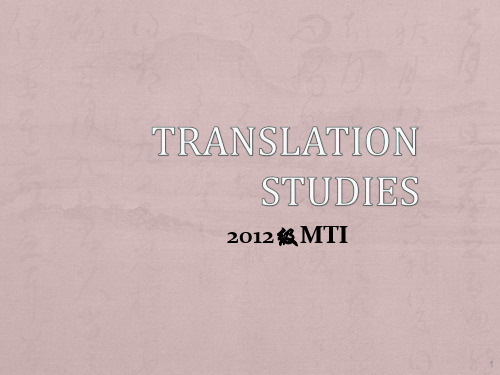
than text + (3) the process(process-oriented DTS): + The psychology of translation, the blackbox,
TAP( thinking aloud protocols)
9
+ Medium-restricted theories: machine/computer; written/spoken; consecutive/simultaneous
7
+ The objectives of the ‘pure’ areas of research are:
+ 1.the description of the phenomena of translation (descriptive translation theory)
+ 2.the establishment of general principles to explain and predict such phenomena.
business, legal, technical + Time-restricted theories: e.g., the history of translation + Problem–restricted theories: e.g., equivalence
10
+ The study of the field developed into an academic discipline only in the second half of the 20th century.
8
+ Examination of: + (1) the product (product-oriented DTS): + description, analysis, comparison of ST and TT + (2) the function(function-oriented DTS): + In the recipient sociocultural situation, i.e. context rather
TAP( thinking aloud protocols)
9
+ Medium-restricted theories: machine/computer; written/spoken; consecutive/simultaneous
7
+ The objectives of the ‘pure’ areas of research are:
+ 1.the description of the phenomena of translation (descriptive translation theory)
+ 2.the establishment of general principles to explain and predict such phenomena.
business, legal, technical + Time-restricted theories: e.g., the history of translation + Problem–restricted theories: e.g., equivalence
10
+ The study of the field developed into an academic discipline only in the second half of the 20th century.
8
+ Examination of: + (1) the product (product-oriented DTS): + description, analysis, comparison of ST and TT + (2) the function(function-oriented DTS): + In the recipient sociocultural situation, i.e. context rather
翻译概论(许均版)青岛大学翻译硕士研究生教材PPT
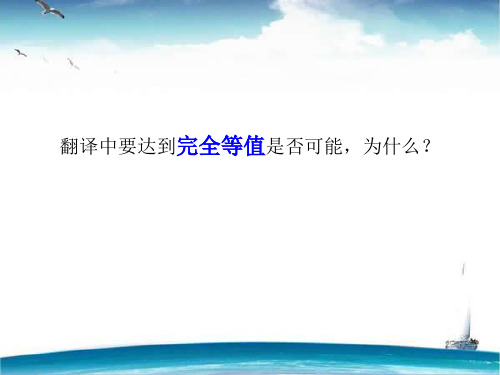
7/17/2015
7/17/2015
• Eg 2: • 奈达对《桃花源记》的英译中对部分译文 修改。其目的是追求译作和原作在情景语 境上的一致。 • 原文:芳草鲜美,落英缤纷(The sweetsmelling grass was fresh and beautiful,and the fallen blossoms scattered in confusion.) • 修改:and the fallen blossoms blanketing/carperting the ground.
7/17/2015
2.2思维差异
• Eg 3: soccer is a difficult sport. A player must be able to run steadily without rest.Sometimes a player must hit the ball with his or her head.Player must be willing to bang into and be banged into by others.They must put up with aching feet and sore muscles.
翻译中要达到完全等值是否可能,为什么?
ห้องสมุดไป่ตู้ • 1 等值翻译的内涵(what) • 2 制约完全等值的因素(why)
7/17/2015
1 等值翻译的内涵
• 1.1 翻译的等值就是表现原文思想内容的完 全准确,和作用上、修辞上与原文完全一 致——费道罗夫《翻译概论》 • 1.2奈达根据自己翻译《圣经》的切身经验 认识到:绝对的翻译等值是不可能的 。他认 为所谓翻译是指在译入语中复制出最接近 源语信息的自然等值,首先表现在意义的 上的等值,其次是风格上的等值。
第一单元翻译概论ppt课件

巴别,希伯来文是“变乱”的意思,巴比伦文则是“神的门”的意思。 由于“巴别塔”故事本身所蕴含的内涵,使人们常常以此作为某种解 释性的典故来利用。一方面作为试图通往天堂的路径,逼近上帝,因 此可以用来表示一种对权威的挑战,无所畏惧的勇气;另外,由于故 事中上帝对人类语言的变乱,则可用以体现人类语言之间的理解偏差, 以及人类为寻求共同理解而不断追求的路途,许多人就把翻译比喻为 一种建造巴别塔般的英雄事业。
呼吁近
近半世纪渐多
“正名”
侧重以诠释学为 肯定译者抉择 基础的翻译理论
主体“介 入”
近二、三十年流 行
侧重以解构主义 等受“后殖民主 义”思潮影响的 翻译理论
强调译者操纵
从上表可以看出,翻译研究界已逐渐开始 重视对译者主体性的研究,但这不能仅仅 停留在一般的呼吁“正名”阶段,而应进 一步探讨“译者背后的总的原因”、机理 和特征,特别是应从理论上真正对译者的 “中心地位”和“主导作用”给与明确的 定位,并据此对翻译过程做出新的、全面 系统地描述和诠释。(胡庚申,2004:54)
翻译的概念可以从广义和狭义两个方面去 理解。广义的翻译指语言与语言、语言与 非语言之间的代码转换和基本信息的传达。 狭义的翻译指一种语言活动,是把一种语 言表达的内容忠实地用另一种语言表达出 来。
季羡林先生在谈到翻译的目的时曾说:“翻译对 于促进人类文化的交流,其作用是不可忽视的。 英国的汤因比说,‘没有任何文明是能永存的。’ 我本人把文化(文明)的发展分为5个阶段:诞生, 成长,繁荣,衰竭,消逝。问题是,既然任何文 化都不能永存,都是一个发展过程,那为什么中 华文化竟能成为例外呢?为什么中华文化竟延续 不断一直存在到今天呢?我想,这里面是因为翻 译在起作用。我曾在一篇文章中说过,若拿河流 来作比较,中华文化这一条长河,有水满的时候, 也有水少的时候,但却从未枯竭。原因就是有新 水注入,注入的次数大大小小是颇多的,最大的 有两次,一次是从印度来的水,一次是从西方来 的水。而这两次的大注入依靠的都是翻译。中华 文化之所以能长葆青春,万应灵药就是翻译。翻 译之为用大矣哉!”
呼吁近
近半世纪渐多
“正名”
侧重以诠释学为 肯定译者抉择 基础的翻译理论
主体“介 入”
近二、三十年流 行
侧重以解构主义 等受“后殖民主 义”思潮影响的 翻译理论
强调译者操纵
从上表可以看出,翻译研究界已逐渐开始 重视对译者主体性的研究,但这不能仅仅 停留在一般的呼吁“正名”阶段,而应进 一步探讨“译者背后的总的原因”、机理 和特征,特别是应从理论上真正对译者的 “中心地位”和“主导作用”给与明确的 定位,并据此对翻译过程做出新的、全面 系统地描述和诠释。(胡庚申,2004:54)
翻译的概念可以从广义和狭义两个方面去 理解。广义的翻译指语言与语言、语言与 非语言之间的代码转换和基本信息的传达。 狭义的翻译指一种语言活动,是把一种语 言表达的内容忠实地用另一种语言表达出 来。
季羡林先生在谈到翻译的目的时曾说:“翻译对 于促进人类文化的交流,其作用是不可忽视的。 英国的汤因比说,‘没有任何文明是能永存的。’ 我本人把文化(文明)的发展分为5个阶段:诞生, 成长,繁荣,衰竭,消逝。问题是,既然任何文 化都不能永存,都是一个发展过程,那为什么中 华文化竟能成为例外呢?为什么中华文化竟延续 不断一直存在到今天呢?我想,这里面是因为翻 译在起作用。我曾在一篇文章中说过,若拿河流 来作比较,中华文化这一条长河,有水满的时候, 也有水少的时候,但却从未枯竭。原因就是有新 水注入,注入的次数大大小小是颇多的,最大的 有两次,一次是从印度来的水,一次是从西方来 的水。而这两次的大注入依靠的都是翻译。中华 文化之所以能长葆青春,万应灵药就是翻译。翻 译之为用大矣哉!”
《第一讲翻译概述》PPT课件

time 重译 interpret again
五、 翻译的起源 (The Origin of Translation)
最早的翻译是口译。翻译的历史和语 言的历史一样长。中国最早的有记载 的翻译始于汉代--西汉(Han Dynasty-Xi Han.)。大约在2000前。我国的翻 译活动经历了五个发展时期。
具体方法:
逐句 sentence by sentence interpretation 逐段 paragraph by paragraph interpretation 即席 impromptu/extemporaneous
interpretation 读稿 interpretation by reading the passage 同声 speech and interpretation at the same
王勃:“海内存知己,天崖若比邻”
科学翻译: If you've on earth a bosom friend He is near you to you though at world apart.
文学翻译: If you have friends who know your heart, Distance cannot keep you apart.
玄奘:
曾于唐太宗贞观2年(公元628年)去 印度求经,17年后带回57部佛经。其 中30部是因明学(逻辑学)。并将75 部 译为汉文。更重要的是他首次进行 汉译外的尝试,把老子的部分著作译 为梵文。成为汉以外的鼻祖。在理论 上,他提倡“既须求真,又须喻俗” 的翻译标准,对后世的翻译实践和理 论研究影响深远。玄奘、鸠摩罗什和 真谛一直被视为我国佛教学三大翻译 家。
我们也尝试给翻译下个定义:翻译是把一种语 言表达的意义用另一种语言传达出来,以达到 沟通思想情感,传播文化知识,促进社会文明, 特别是推动译入语文化信兴旺发达的目的。
五、 翻译的起源 (The Origin of Translation)
最早的翻译是口译。翻译的历史和语 言的历史一样长。中国最早的有记载 的翻译始于汉代--西汉(Han Dynasty-Xi Han.)。大约在2000前。我国的翻 译活动经历了五个发展时期。
具体方法:
逐句 sentence by sentence interpretation 逐段 paragraph by paragraph interpretation 即席 impromptu/extemporaneous
interpretation 读稿 interpretation by reading the passage 同声 speech and interpretation at the same
王勃:“海内存知己,天崖若比邻”
科学翻译: If you've on earth a bosom friend He is near you to you though at world apart.
文学翻译: If you have friends who know your heart, Distance cannot keep you apart.
玄奘:
曾于唐太宗贞观2年(公元628年)去 印度求经,17年后带回57部佛经。其 中30部是因明学(逻辑学)。并将75 部 译为汉文。更重要的是他首次进行 汉译外的尝试,把老子的部分著作译 为梵文。成为汉以外的鼻祖。在理论 上,他提倡“既须求真,又须喻俗” 的翻译标准,对后世的翻译实践和理 论研究影响深远。玄奘、鸠摩罗什和 真谛一直被视为我国佛教学三大翻译 家。
我们也尝试给翻译下个定义:翻译是把一种语 言表达的意义用另一种语言传达出来,以达到 沟通思想情感,传播文化知识,促进社会文明, 特别是推动译入语文化信兴旺发达的目的。
翻译概论PPT课件

Section Two
China’s History of Translation and the Famous Translators 第二节 我国翻译历史及 著名翻译家
China recorded
has a long in history
bhoisotko.srythoaft
translation. as early as
It ‘s four
thousand years ago in the Xia Dynasty(夏
朝), there were communications between the
people of different tribes in our country. But
that was mainly by spoken letation. The earliest large scale written
translation is the translation of Buddhist
Scriptures in the Tang Dynasty(唐朝).
From that time on, the history of translation in
Translation (written translation) Interpretation (oral translation)
.
According to the object (客体) of translation, it can be classified into:
Literary translation(文学翻译) Pragmatic translation(实用翻译)
.
II. Classification of
翻译概论课件

Shuttle: 纺织行业的“梭子”,航天方 面的“航天飞机”、“穿梭机”
4.根据汉语搭配习惯确定词义
She proves to be a good listener. 她在课堂上认真听讲。 她是个遵守公共秩序的/忠实的听众。 她善于听取群众的意见。
Yet, as it sometimes happens that a person departs his life, who is really deserving of the praise the stone cutter curves over his bones; who is a good Christian, a good parent, a good child, a good wife or a good husband.
所求的不在形似而在神似。” (spiritual conformity/resemblance in spirit )
钱钟书: “文学翻译的最高标准是‘化’。把 作品从一国文字转变成另一国文字,既不能 因语文习惯的差异而露出生硬牵强的痕迹, 又能完全保存原有的风味,那就算得入于
‘化境’” (transmigration)
run into debt 负债 run one’s head into a wall 撞南墙,碰壁 The idea runs in his mind. 这个念头萦绕在
他的脑海里。
The street runs north. 大街向北延伸。 The news runs rapidly in the town. 这个消
A COURSE OF TRANSLATION
[ENTER]
翻译概论
What is translation?
译即易,谓换易言语使相解也。 (贾公彦 )
4.根据汉语搭配习惯确定词义
She proves to be a good listener. 她在课堂上认真听讲。 她是个遵守公共秩序的/忠实的听众。 她善于听取群众的意见。
Yet, as it sometimes happens that a person departs his life, who is really deserving of the praise the stone cutter curves over his bones; who is a good Christian, a good parent, a good child, a good wife or a good husband.
所求的不在形似而在神似。” (spiritual conformity/resemblance in spirit )
钱钟书: “文学翻译的最高标准是‘化’。把 作品从一国文字转变成另一国文字,既不能 因语文习惯的差异而露出生硬牵强的痕迹, 又能完全保存原有的风味,那就算得入于
‘化境’” (transmigration)
run into debt 负债 run one’s head into a wall 撞南墙,碰壁 The idea runs in his mind. 这个念头萦绕在
他的脑海里。
The street runs north. 大街向北延伸。 The news runs rapidly in the town. 这个消
A COURSE OF TRANSLATION
[ENTER]
翻译概论
What is translation?
译即易,谓换易言语使相解也。 (贾公彦 )
英译汉之翻译概论-ppt

翻译行业的发展趋势与人才培养
翻译行业的发展趋势
随着全球化进程的不断加速和信息技术的发展,翻译行业正面临着数字化、自动化的趋势。同时,随 着各种新领域、新技术的出现,如人工智能、生物科技等,专业化的翻译需求也在不断增加。
翻译人才的培养
为了适应翻译行业的发展趋势,需要加强翻译人才的培养。高校和培训机构应注重培养学生的语言技 能和跨文化交流能力,同时还需要加强对学生信息技术和专业知识的教学。此外,为了提高翻译行业 的整体水平,还需要建立完善的翻译标准和评价体系。
新闻翻译的特点
新闻翻译要求准确、及时、流畅,同时要保留原文的新闻价值。
新闻翻译的难点
新闻报道中涉及大量专有名词、术语,需要进行准确翻译。同时, 新闻语言具有独特的表达方式,需要准确把握原文含义。
案例分析
某英文新闻报道关于国际政治事件的翻译,需要准确传达原文含义, 同时要符合中文的表达习惯。
广告翻译
考虑文化背景
结合目标语言的文化背景,理解 原文中隐含的意义,避免因文化 差异造成误解。
表达阶段
01
选择恰当词汇
根据语境选择最合适的词汇,确 保译文流畅自然,符合目标语言 的表达习惯。
02
重构句子结构
03
保持原文风格
在保持原文意思的基础上,对句 子结构进行重构,使其更符合目 标语言的语法规则和表达习惯。
翻译的目的是使读者能够理解和欣赏原作的思想 内容、风格特点和艺术价值。
翻译的分类
根据翻译的性质,可以分为直译和意译。直译注重保持原 文的语言形式和表达方式,而意译则更注重传达原文的思 想内容和意义。
根据翻译的领域,可以分为文学翻译、科技翻译、商务翻 译等。不同领域的翻译要求不同的专业知识和表达方式。
(翻译概论教学课件)第四章当代西方翻译理论

¡ 语义翻译与交际翻译是纽马克翻译理论的核心内容。语 义翻译试图在译人语的语义和句法结构允许的范围内传达 原著的确切上下文意义。交际翻译试图对译文读者产生一 种效果,这效果要尽可能接近原文对读者所产生的效果。 语义翻译的服务对象是原语作者,交际翻译服务的对象是 译入语的读者。这两种方法的一个根本区别在于: 当出现 矛盾时,交际翻译必须强调“ 表现力” ,而不强调信息 的内容。。
¡ 意大利美学家、文学评论家克罗齐在《美学原理》提出了完全相等于 原作表达方式的翻译不可能存在, 翻译必须靠再创造。文学翻译不 可过分自由、专业翻译不可过分拘谨的观点, 他是从美学的角度谈 翻译的。
¡ 西奥多·萨瓦里的翻译理论主要在《翻译的艺术》, 这被誉为“英语 中论述翻译的最佳之作”。他指出, 翻译是一门艺术。他把文学翻 译比作绘画, 把科技翻译比作摄影。将翻译分为完美翻译、等值翻 译、综合翻译、科技翻译四种。完美的翻译即纯粹传递信息的翻译, 等值翻译是不拘形式, 只管内容的翻译, 科技翻译的特点与等值翻 译有相似之处, 因为在科技翻译中, 内容的重要性远超过语言表达 形式的重要性。他归纳了12条准则指导翻译实践。。
第四章 当代西方翻译理论
¡ 英国翻译学家纽马克将西方研究翻译的历史划分为两大时期: 从公元前55年到20世纪上半叶属于语言学前时期, 20世纪 下半叶则属语言学时期。美国语言学家兼圣经翻译家奈达则 认为西方的翻译理论有四大流派: 语文学派、语言学派、交 际学派和社会符号学派。语言学前时期主要翻译圣经和文学 作品,翻译主要是少数人的事,这个时期的翻译理论就是奈 达所说的语文学派的理论。后三种理论流派即纽马克所说的 语言学时期的翻译理论。
¡ 奈达认为,一般意义上翻译过程包括以下几个阶段: 分析、转 移和重
组(analysis, transfer, and reconstruct),即首先 分析原作语言的息,将其剖析成结构上最简单明了的形式,在 此基础上转移,然后再
¡ 意大利美学家、文学评论家克罗齐在《美学原理》提出了完全相等于 原作表达方式的翻译不可能存在, 翻译必须靠再创造。文学翻译不 可过分自由、专业翻译不可过分拘谨的观点, 他是从美学的角度谈 翻译的。
¡ 西奥多·萨瓦里的翻译理论主要在《翻译的艺术》, 这被誉为“英语 中论述翻译的最佳之作”。他指出, 翻译是一门艺术。他把文学翻 译比作绘画, 把科技翻译比作摄影。将翻译分为完美翻译、等值翻 译、综合翻译、科技翻译四种。完美的翻译即纯粹传递信息的翻译, 等值翻译是不拘形式, 只管内容的翻译, 科技翻译的特点与等值翻 译有相似之处, 因为在科技翻译中, 内容的重要性远超过语言表达 形式的重要性。他归纳了12条准则指导翻译实践。。
第四章 当代西方翻译理论
¡ 英国翻译学家纽马克将西方研究翻译的历史划分为两大时期: 从公元前55年到20世纪上半叶属于语言学前时期, 20世纪 下半叶则属语言学时期。美国语言学家兼圣经翻译家奈达则 认为西方的翻译理论有四大流派: 语文学派、语言学派、交 际学派和社会符号学派。语言学前时期主要翻译圣经和文学 作品,翻译主要是少数人的事,这个时期的翻译理论就是奈 达所说的语文学派的理论。后三种理论流派即纽马克所说的 语言学时期的翻译理论。
¡ 奈达认为,一般意义上翻译过程包括以下几个阶段: 分析、转 移和重
组(analysis, transfer, and reconstruct),即首先 分析原作语言的息,将其剖析成结构上最简单明了的形式,在 此基础上转移,然后再
翻译概论精品PPT课件
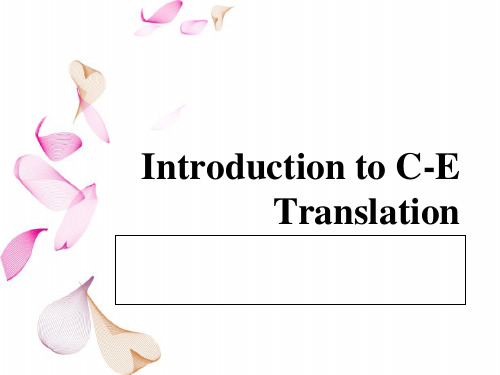
• faithfulness,
• expressiveness,
• elegance.
• In 1791, a British theorist Alexander Fraser Tytler wrote a book entitled “Essays on the Principles of Translation” on which he proposed three principles for translation:
翻译概论
Teaching Contents:
• 1. Definition • 2. Nature • 3. Scope of translation • 4. Principles/Criteria of Translation • 5. Processes of Translation
The Tower of Babel
2. Principles/Criteria of Translation
• In 1791, a British theorist Alexander Fraser Tytler wrote a book entitled “Essays on the Principles of Translation” on which he proposed three principles for translation:
• 3) The translation should have all the ease of the original composition.
• In fact, these principles coincide with the criteria proposed by a famous Chinese translator Yanfu, which are
• expressiveness,
• elegance.
• In 1791, a British theorist Alexander Fraser Tytler wrote a book entitled “Essays on the Principles of Translation” on which he proposed three principles for translation:
翻译概论
Teaching Contents:
• 1. Definition • 2. Nature • 3. Scope of translation • 4. Principles/Criteria of Translation • 5. Processes of Translation
The Tower of Babel
2. Principles/Criteria of Translation
• In 1791, a British theorist Alexander Fraser Tytler wrote a book entitled “Essays on the Principles of Translation” on which he proposed three principles for translation:
• 3) The translation should have all the ease of the original composition.
• In fact, these principles coincide with the criteria proposed by a famous Chinese translator Yanfu, which are
翻译概论 ppt课件
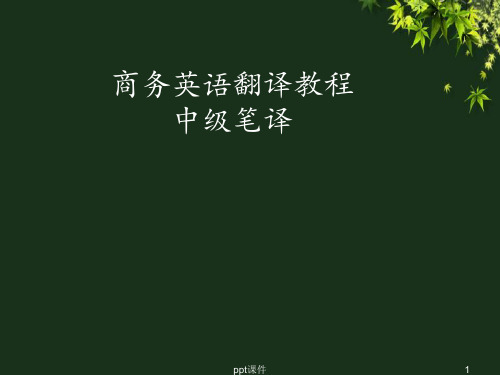
• D. Revision /proofreading: check again and again to polish the language.
Eugene A. Nida 的翻译过程
source language
target language
(言) 甲(原语)
乙(译语) (言)
(象) (分析)
比较分析
例句:These three steps constituted an epochal(划时代的) advance.
(重构) (象)
(意)
X
(传译)
Y
(意)
理解阶段
表达阶段
图1:
奈达的翻译过程模式
翻译p中pt课的件形象思维过Translation in China
• 1.古代:玄奘(佛经翻译),徐光启(数学、天文学 等科技翻译)
• (古代佛经三大翻译家:玄奘、鸠摩罗什、释道安)
IV.i. Criteria in China 国内翻译标准
• C. Fu Lei’s (傅雷) spiritual conformity/resemblance in spirit (神似)
• D. Qian Zhongshu (钱钟书) transmigration (化境)
• E. 鲁迅:翻译:一当然力求其易解,一则保存原作的 丰姿。反对牛头不对马嘴,提出“宁信而不顺”之原 则
• 翻译是把一种语言表达的意义用另一种语言传达出来, 以达到沟通思想情感、传播文化知识、促进社会文明, 特别是推动译语文化兴旺昌盛的目的。
II.The Process of Translation 翻译的过程
• A. Preparation: basic knowledge about both languages as well as the background knowledge; basic skills in translation are necessary;
Eugene A. Nida 的翻译过程
source language
target language
(言) 甲(原语)
乙(译语) (言)
(象) (分析)
比较分析
例句:These three steps constituted an epochal(划时代的) advance.
(重构) (象)
(意)
X
(传译)
Y
(意)
理解阶段
表达阶段
图1:
奈达的翻译过程模式
翻译p中pt课的件形象思维过Translation in China
• 1.古代:玄奘(佛经翻译),徐光启(数学、天文学 等科技翻译)
• (古代佛经三大翻译家:玄奘、鸠摩罗什、释道安)
IV.i. Criteria in China 国内翻译标准
• C. Fu Lei’s (傅雷) spiritual conformity/resemblance in spirit (神似)
• D. Qian Zhongshu (钱钟书) transmigration (化境)
• E. 鲁迅:翻译:一当然力求其易解,一则保存原作的 丰姿。反对牛头不对马嘴,提出“宁信而不顺”之原 则
• 翻译是把一种语言表达的意义用另一种语言传达出来, 以达到沟通思想情感、传播文化知识、促进社会文明, 特别是推动译语文化兴旺昌盛的目的。
II.The Process of Translation 翻译的过程
• A. Preparation: basic knowledge about both languages as well as the background knowledge; basic skills in translation are necessary;
翻译概论-精品.ppt
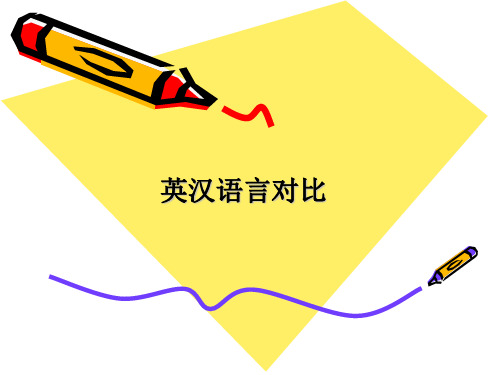
example
• July 6, 2019
• Dear Tom,
• I am sorry to inform you that I won’t be able to go to dance with you this weekend. My mother is suddenly taken ill. In order not to disappoint you, I have asked Susan to take my place. She is a better dancer, I think. My regrets.
• At the words, we scattered at once。
• “神州六号载人宇宙飞船 成功发射并安全返回,令 中国人民欢欣鼓舞!”
• The successful launch and safe return of the manned spaceship VI has inspired the whole China.
•语法功能不一而足,
• 可作主语、谓语、宾 语、定语、状语与表 语等
• I am utterly in the dark about the matter.
• 我对这件事情完全不知道。 (介词词组“in the dark”作 表语)
• Christmas is coming up.
• 圣诞节就要到了。(动词 短语“come up”作谓语)
• Just less than three decades ago, fortune was still one of the most unpopular words with the Chinese, who often linked the pursuit of money and wealth with capitalism and exploitation.
翻译概论PPT

而文艺学派认为翻译是艺术活动,追求的是再创造。
18
2.4 研究视角的多元整合
勒弗维尔指出:“翻译并非在两种语言的真空中进行, 而是在两种文学传统的语境下进行的。译者作用于特 定时间的特定文化之中。他们对自己和自己文化的理 解,是影响他们翻译方法的诸多因素之一”。9
语言对比和价值评判层面
两种文化
2.就翻译学研究而言,对语言之外的各种要素的关注 都是应该而必须的,但是如果要建立起翻译学的知识 体系,语言要素是最主要的因素,因为任何翻译活动 都是以语言作为媒介的。
3.我们应该认识到语言学派的翻译理论家们为推动译 学研究的发展做出的积极探索,但是也要认识到译学 研究的语言学探索过程中还有很多内容没有深涉,深 度和广度也有待加强。9
4. 范晓.语言、言语和话语[J]. 汉语学习. 1994.
9
奈达的对等理论:
奈达对翻译理论提出指导原则,阐明了形式对应和动 态对等(即功能对等)两个概念。其核心是:译文措 辞通顺自然,内容达意传神,读者反应相似。5
形式对应即译者直接把源语转换成目的语,译者把重 点放在原文或源语的表达形式上,译者尽可能的使目 的语的表达形式与源于的表达形式一样。6
5. 谭载喜. 西方翻译简史[M]. 北京:商务印书馆, 2004.
6. 赵丹丹. 浅论奈达的功能对等理论[J]. 文中教育(中). 2011.
10
奈达的对等理论:
所谓“动态对等”, 就是说翻译时不求文字表面的死板对应, 而要在两种语言间达成功能上的对等。
Dynamic equivalence is therefore to be defined in terms of the degree to which the receptors of the message in the receptors language respond to it in substantially the same manner as the receptors in the source language.(Nida, 2004:24)
18
2.4 研究视角的多元整合
勒弗维尔指出:“翻译并非在两种语言的真空中进行, 而是在两种文学传统的语境下进行的。译者作用于特 定时间的特定文化之中。他们对自己和自己文化的理 解,是影响他们翻译方法的诸多因素之一”。9
语言对比和价值评判层面
两种文化
2.就翻译学研究而言,对语言之外的各种要素的关注 都是应该而必须的,但是如果要建立起翻译学的知识 体系,语言要素是最主要的因素,因为任何翻译活动 都是以语言作为媒介的。
3.我们应该认识到语言学派的翻译理论家们为推动译 学研究的发展做出的积极探索,但是也要认识到译学 研究的语言学探索过程中还有很多内容没有深涉,深 度和广度也有待加强。9
4. 范晓.语言、言语和话语[J]. 汉语学习. 1994.
9
奈达的对等理论:
奈达对翻译理论提出指导原则,阐明了形式对应和动 态对等(即功能对等)两个概念。其核心是:译文措 辞通顺自然,内容达意传神,读者反应相似。5
形式对应即译者直接把源语转换成目的语,译者把重 点放在原文或源语的表达形式上,译者尽可能的使目 的语的表达形式与源于的表达形式一样。6
5. 谭载喜. 西方翻译简史[M]. 北京:商务印书馆, 2004.
6. 赵丹丹. 浅论奈达的功能对等理论[J]. 文中教育(中). 2011.
10
奈达的对等理论:
所谓“动态对等”, 就是说翻译时不求文字表面的死板对应, 而要在两种语言间达成功能上的对等。
Dynamic equivalence is therefore to be defined in terms of the degree to which the receptors of the message in the receptors language respond to it in substantially the same manner as the receptors in the source language.(Nida, 2004:24)
PPT 翻译概论 第四章

杨绛《失败的经验---试探翻译》
三原则
去字梏: 单词 重组句: 句子 建空间: 篇章
英语口译 梁丽娅
莫里斯对意义的分类:
1.指称意义:指语言符号和它所描绘或叙述的 主观世界获客观世界的实体和事件之间的关系。 (= 概念意义,认知意义) 语言符号的基本内容和它所传递的主要信息。 ( VS 字面意义) 2.言内意义:语言符号之间的关系,体现在语言 符号的音韵,语法,词汇,句子和话语等各个 层面。 3.语用意义:语言符号与符号使用者——包括 收讯人和发讯人——之间的关系(主观性)
法国释意派对意义的分类:
最大的贡献是:区分了潜在意义和现实化意 义; 释意派的弟子安帕罗· 于塔多· 阿尔比 在《富裕的“忠实”概念》中发展了释义派 理论对意义的认识。
分类:
1. 涵意,现实化涵义与意义
现实化涵义是意义的一部分
2. 信息与意义 3. 效果与意义
被理解的意义是效果引发的因素
4. 意图与意义
4.3 意义的分类 4.4 在交流中让意义再生
英语口译 梁丽娅
什么是意义?
意义不是一种客观的,唯一的确定的 存在,意义的这一特质就给翻译活动 造成了很大的障碍。所以,译者在遇 到难以克服的的障碍并无法完全赋原 文本的意义以再生时,译者须分清轻 重,主次,尽可能减少语义损失。
奈达对意义的分类
早期分类:
所指意义
(字面意义)
联想意义
(言外之意)
Nida said, " Translating consists in reproducing inthe receptor language the clesest equivalent of the soure-language messege, first in terms og meaning and secondly in terms of style.
三原则
去字梏: 单词 重组句: 句子 建空间: 篇章
英语口译 梁丽娅
莫里斯对意义的分类:
1.指称意义:指语言符号和它所描绘或叙述的 主观世界获客观世界的实体和事件之间的关系。 (= 概念意义,认知意义) 语言符号的基本内容和它所传递的主要信息。 ( VS 字面意义) 2.言内意义:语言符号之间的关系,体现在语言 符号的音韵,语法,词汇,句子和话语等各个 层面。 3.语用意义:语言符号与符号使用者——包括 收讯人和发讯人——之间的关系(主观性)
法国释意派对意义的分类:
最大的贡献是:区分了潜在意义和现实化意 义; 释意派的弟子安帕罗· 于塔多· 阿尔比 在《富裕的“忠实”概念》中发展了释义派 理论对意义的认识。
分类:
1. 涵意,现实化涵义与意义
现实化涵义是意义的一部分
2. 信息与意义 3. 效果与意义
被理解的意义是效果引发的因素
4. 意图与意义
4.3 意义的分类 4.4 在交流中让意义再生
英语口译 梁丽娅
什么是意义?
意义不是一种客观的,唯一的确定的 存在,意义的这一特质就给翻译活动 造成了很大的障碍。所以,译者在遇 到难以克服的的障碍并无法完全赋原 文本的意义以再生时,译者须分清轻 重,主次,尽可能减少语义损失。
奈达对意义的分类
早期分类:
所指意义
(字面意义)
联想意义
(言外之意)
Nida said, " Translating consists in reproducing inthe receptor language the clesest equivalent of the soure-language messege, first in terms og meaning and secondly in terms of style.
新英汉翻译课件教程 Chapter 1 翻译概论

• Contrast is the spice of life. There can
be no joy without sorrow, no summer without winter, no love without hate. • 【译文】矛盾是生活的调味品:没有悲伤就 没有快乐;没有冬就没有夏;没有恨就没有 爱。 • 【解析】充满哲理,令人信服。译文和原文 一样挥洒自如,如歌似曲。
课堂互动 1:找找哪个译文正确
• 1.He has a weakness for smoking.
•
– A.他有抽烟的缺点。 – B.他有抽烟的癖好。 2.A cat is a cleanly animal. – A.猫是一种干净的动物。 – B.猫是喜爱清洁的动物。
• 3.He is dead,as I live.
•
钱钟书提出文学翻译的最高标准是“化”。把作 品从一国文字转变为另一国文字,既不能因语 言习惯的差异而露出生硬牵强的痕迹,又能完 全保存原有的风味,那就算得上是入于“化” 境了。 谭载喜提出了翻译的“东张西望”法和译学内 容的“瞻前顾后”法。“东张”即发挥自身的 语言优势,做到译文的“信达贴”、“信达 切”、“神似”、“化境”。“西望”则是借 鉴西方译论,立足分析,注重理论,放眼系统。 “瞻前”——放开思路,大胆开拓;“顾 后”——继承传统,推陈出新。
黄昏的阴影几乎连在一起,不可分别,岁将云暮,终日昏 暗,我就在这么一天,到西敏大寺去散步了几个钟头。 • 【解析】此译文对原文语序略作调整,译文表达忠实、正 确、流畅,符合汉语习惯。但现代人读来文字华丽、感到 过于学究气,和原语文本中所用文字和所表达语气似乎相 悖。 • 【译文】时值晚秋,天气肃杀凄凉,令人伤感,晨日的光 影与黄昏的光影几乎交织在一起,难以分辨,昏暗的光线 投射到一年的衰败秋日之中,而就在这样的一天,我独自 到西敏寺大教堂散步了几个小时。
翻译概论课件..
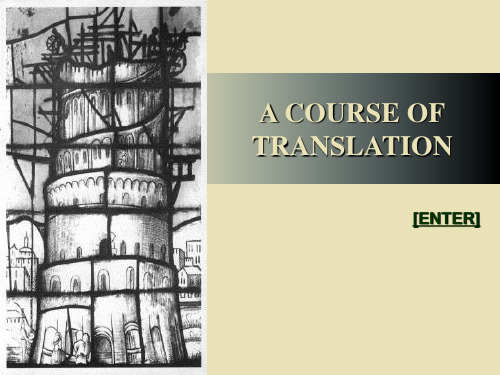
Yet, as it sometimes happens that a person departs his life, who is really deserving of the praise the stone cutter curves over his bones; who is a good Christian, a good parent, a good child, a good wife or a good husband.
run into debt 负债 run one’s head into a wall 撞南墙,碰壁 The idea runs in his mind. 这个念头萦绕在 他的脑海里。 The street runs north. 大街向北延伸。 The news runs rapidly in the town. 这个消 息迅速在镇上传开。
鲁迅:“真好像做苦工,日子不好过”、 “字典不离手,冷汗不离身”。 傅雷:我译文的风格,令自己深以为苦,虽 已尽全力,却永远达不到满意的完美程 度……我尽量尝试译得忠于原文,而又不失 艺术性,务使译文看来似中文创作,惜仍然 力不从心。翻译之难,比起演奏家之演绎往 昔大师的杰作,实在不遑多让。
英汉词法翻译
1.根据语境确定词义 英语中一词多义、汉语中一字多义,这 是常见的语言现象。这就需要我们依靠 具体的上下文来判断某一个字或词语的 意义。
right
And not only has won, but because it has won, has been in the right. Adj.正义的 Might is right. n.公理 She tried her best to right her husband from the charge of robbery. Vt.申冤 You are quite right to refuse. Adj. 正确的 All came right in the end. Adv. 顺利
run into debt 负债 run one’s head into a wall 撞南墙,碰壁 The idea runs in his mind. 这个念头萦绕在 他的脑海里。 The street runs north. 大街向北延伸。 The news runs rapidly in the town. 这个消 息迅速在镇上传开。
鲁迅:“真好像做苦工,日子不好过”、 “字典不离手,冷汗不离身”。 傅雷:我译文的风格,令自己深以为苦,虽 已尽全力,却永远达不到满意的完美程 度……我尽量尝试译得忠于原文,而又不失 艺术性,务使译文看来似中文创作,惜仍然 力不从心。翻译之难,比起演奏家之演绎往 昔大师的杰作,实在不遑多让。
英汉词法翻译
1.根据语境确定词义 英语中一词多义、汉语中一字多义,这 是常见的语言现象。这就需要我们依靠 具体的上下文来判断某一个字或词语的 意义。
right
And not only has won, but because it has won, has been in the right. Adj.正义的 Might is right. n.公理 She tried her best to right her husband from the charge of robbery. Vt.申冤 You are quite right to refuse. Adj. 正确的 All came right in the end. Adv. 顺利
- 1、下载文档前请自行甄别文档内容的完整性,平台不提供额外的编辑、内容补充、找答案等附加服务。
- 2、"仅部分预览"的文档,不可在线预览部分如存在完整性等问题,可反馈申请退款(可完整预览的文档不适用该条件!)。
- 3、如文档侵犯您的权益,请联系客服反馈,我们会尽快为您处理(人工客服工作时间:9:00-18:30)。
(重构) (象)
(意)
X
(传译)
Y
(意)
理解阶段
图1:
表达阶段
奈达的翻译过程模式 翻译中的形象思维过程模式
III. History of Translation in China
• 1.古代:玄奘(佛经翻译),徐光启(数学、天文学 等科技翻译)
• (古代佛经三大翻译家:玄奘、鸠摩罗什、释道安)
• 2.近代:严复(政治、哲学、社会学翻译),林纾 (文学翻译),马建忠(语言学翻译),辜鸿铭(中 译英)
• 3)A translation should have all the ease of the original
composition.(译文应和原作同样流畅)
•
— by Alexander Fraser Tytler,1749-1814
IV.iii. 初学者的标准
• 1.faithfulness/accuracy忠实
商务英语翻译教程 中级笔译
翻译概论
I.What is translation?
• I. Definition 翻译的定义
• Translation is an activity of reproducing in one language the ideas which have been expressed in another language.
nd still beneath the pines… *译文1:这具尸体苍白而安静地躺在松树下…… 译文2:这具尸体苍白而静静地躺在松树下……
2. 通 顺
• 例句: As the weather was fine, we decided to climb the mountain.
译文1:由于天气很好,我们决定去爬山。 译文2:天气很好,我们决定去爬山。
• D. Revision /proofreading: check again and again to polish the language.
Eugene A. Nida 的翻译过程
source language
target language
(言) 甲(原语)
乙(译语) (言)
(象) (分析)
1. 忠实
• 例句:The president stands there, hat in hand ,begging Congress for their votes. *译文1:总统站在那里,手里拿着礼帽,乞求国会投 他的票。 译文2:总统站在那里,手里拿着礼帽,必恭必敬地请 求国会议员们投赞成票。
• 翻译是把一种语言表达的意义用另一种语言传达出来, 以达到沟通思想情感、传播文化知识、促进社会文明, 特别是推动译语文化兴旺昌盛的目的。
II.The Process of Translation 翻译的过程
• A. Preparation: basic knowledge about both languages as well as the background knowledge; basic skills in translation are necessary;
• 3.现当代:鲁迅(文学),瞿秋白(马克思主义哲学、 苏俄文学)、梁实秋,林语堂,傅雷,钱钟书,朱生 豪等(戏剧)
IV. Criteria of translation 翻译的标准
• i.Criteria in China • 国内翻译标准 • ii. Criteria in the West • 国外翻译标准 • iii. 初学者的标准
• B. Comprehension: understanding accurately the meaning of the source language;
• C. Expression/Representation: try to express the meaning in idiomatic Chinese/English;
• not only to the original contents, to the original meaning and views, but also to the original form and style.
• 2.smoothness通顺
• not only easy and readable rendering, but also idiomatic expression in the target language, free from stiff formula and mechanical copying from dictionaries
• Three Principles of Translation
• 1)A translation should give a complete transcript of the ideas of the original work.(译文应完全复写出原作的思 想)
• 2)The style and manner of writing should be of the same character as that of the original.(译文的风格和笔调应与 原文的性质相同)
IV.i. Criteria in China 国内翻译标准
• C. Fu Lei’s (傅雷) spiritual conformity/resemblance in spirit (神似)
• D. Qian Zhongshu (钱钟书) transmigration (化境)
• E. 鲁迅:翻译:一当然力求其易解,一则保存原作的 丰姿。反对牛头不对马嘴,提出“宁信而不顺”之原 则
• 林语堂的“忠实、通顺、美”
• 梁实秋的“宁错务顺”
• 瞿秋白的“信顺统一”
严复:信、达、雅
• 信----忠实 faithfulness /
Loyalty/ accuracy
• 达----expressiveness----通顺
fluency
• 雅----优美elegance
IV.ii. Criteria in the West 国外翻译标准
